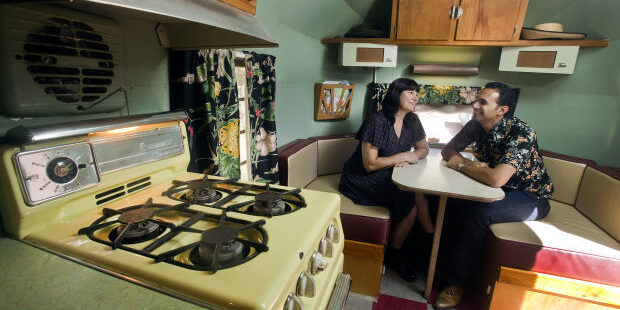Lighting Up the History of Austin’s Last Original Arby’s Sign

The vintage Arby’s 10-gallon hat sign at 4411 South Lamar Boulevard. Photo by Melissa Boice.
From Towers: At 4411 South Lamar Boulevard, in the southeastern corner of the snarl where Highway 290 meets Highway 71, you’ll find the oldest of Austin’s three Arby’sfranchises, as well as the city’s only remaining original neon 10-gallon hat sign — which used to grace every new location of the fast food roast beefery during the brand’s original heyday in the ’60s and ’70s.
Channeling the buckaroo bravado of the “Old West” popularized in the ‘60s, Arby’s adopted the 10-gallon hat as its signature logo when the restaurant’s first location opened in Boardman, Ohio, in 1964. Its outposts were originally housed in curvilinear Conestoga wagon-style buildings with wood and stone decor. A fun fact: Arby’s founders Leroy and Forrest Raffel first wanted to name their concept “Big Tex,” but that was already taken by an Akron business. Still, the Texan roots implied by their original choice of name are not-so-subtly expressed by the giant hat, don’t you think?
SCAD, Savannah preservationists debate fate of Howard Johnson’s downtown motor lodge

The Savannah College of Art and Design is planning on demolishing the former Howard Johnson’s motor lodge, including the A-frame gatehouse seen here on Sept. 25, in order to construct student housing. Photo: Eric Curl/Savannahnow.com
From SavannahNow/Savannah Morning News: More commonly recognized for restoring aging structures, the Savannah College of Art and Design’s plan to demolish a former Howard Johnson’s motor lodge recently instigated a debate about what downtown buildings should be considered historic.
“I was surprised,” said Historic Savannah Foundation president and CEO Daniel Carey. “If there is any institution within this community that could do something creative with the building, it would be SCAD.”
Between 1954 and 1973, the Howard Johnson company built 29 motor lodges in Georgia, four of which shared the same “roadside” style design that drivers can see when entering downtown Savannah from the Talmadge Bridge exit onto Oglethorpe Avenue, according to a SCAD report.
‘New York Has Always Been About Light to Me’: Artist Mary Weatherford Turns On the Neon for Her Inaugural Show at Gagosian

Mary Weatherford, GLORIA (2018). Photo by Fredrik Nilsen Studio, courtesy of Gagosian. ©Mary Weatherford
From Artnet News: The massive paintings are made using vinyl-based Flashe paint on linen canvasses made specially for the artist at a Belgian mill, from flax grown in nearby fields. Working in solitude—even knowing someone else is in the building can be a distraction for Weatherford—she lays out the canvas on a perfectly level wooden platform, pouring water across the surface before adding her pigment, which she manipulates with grouting sponges. The artist likens the process to that of a child playing with silt in the bottom of a rain puddle.
Weatherford’s paintings are deceptively effortless looking—bright blooms of color spread across the canvas in sweeping arcs. But the process is actually incredibly physically taxing. The artist draws on her dance background—“even though I’m a mediocre dancer,” she qualified—to make each work.
Exploring the Abandoned Buildings and Roadside Attractions Along Route 66 (PHOTOS)

Photographer Liz Roll traveled sections of Route 66 to photograph what’s left of the historic interstate. Above is the Wigwam Village Motel #6 in Holbrook, Ariz., where Roll and family members stayed during a part of their exploration of Route 66. Photo: Liz Roll
From The Weather Channel: Route 66 was officially opened for motorists on November 11, 1926, though parts of the route had been used since the 1850s. The 2,448-mile road with many nicknames connected rural Midwestern communities to Chicago and to California, and was called the “road to opportunity” by migrants heading west and those fleeing the Dust Bowl in the 1930s.
After World War II, businesses along the interstate boomed as Americans were more mobile than ever before. Restaurants, motels, auto service garages and roadside attractions popped up out of the desert to provide food, comfort, assistance and entertainment to thousands of travelers. In the 1950s, Route 66 became the main path for vacationers heading to Los Angeles, and tourism became a major money-maker for the route. Motels modeled after teepees, Native American gift shops and reptile farms sprouted and flanked the highway. The country’s first drive-through restaurant was built along Route 66 in Springfield, Missouri, to meet the needs of customers on the go, giving rise to the fast food movement.
Learn Tucson’s history at these Modernism Week events

Husband and wife Alex Mastrangelo and Michelle Haller pose for portraits inside their vintage 1957 El Rey trailer at their midtown home on Tuesday, Sept. 24, 2013. Photo: Mike Christy Arizona Daily Star
From Tucson.com: You don’t have to be an expert on Gottschalk furniture or the architectural works of Alexander Girard to get the most out of Tucson Modernism Week.
The annual homage to the city’s Mid-Century past, running Friday, Oct. 5 to the 14, has numerous events that appeal to broader audiences.
Find a full list of events on Preserve Tucson‘s website.


